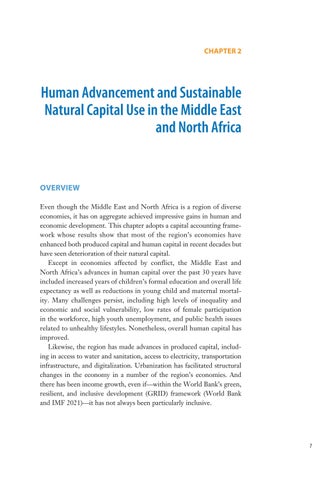CHAPTER 2
Human Advancement and Sustainable Natural Capital Use in the Middle East and North Africa
OVERVIEW Even though the Middle East and North Africa is a region of diverse economies, it has on aggregate achieved impressive gains in human and economic development. This chapter adopts a capital accounting framework whose results show that most of the region’s economies have enhanced both produced capital and human capital in recent decades but have seen deterioration of their natural capital. Except in economies affected by conflict, the Middle East and North Africa’s advances in human capital over the past 30 years have included increased years of children’s formal education and overall life expectancy as well as reductions in young child and maternal mortality. Many challenges persist, including high levels of inequality and economic and social vulnerability, low rates of female participation in the workforce, high youth unemployment, and public health issues related to unhealthy lifestyles. Nonetheless, overall human capital has improved. Likewise, the region has made advances in produced capital, including in access to water and sanitation, access to electricity, transportation infrastructure, and digitalization. Urbanization has facilitated structural changes in the economy in a number of the region’s economies. And there has been income growth, even if—within the World Bank’s green, resilient, and inclusive development (GRID) framework (World Bank and IMF 2021)—it has not always been particularly inclusive.
7






